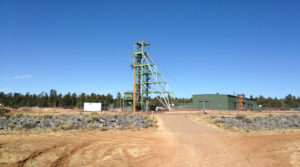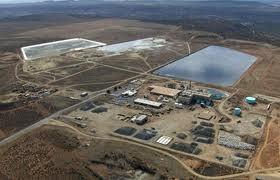Awareness & Action Tour to Stop Canyon Mine Planned for Spring 2017
December 15, 2016
Grand Canyon, AZ — Energy Fuels Inc. is planning to poison the Grand Canyon including the precious Colorado River. Are we going to let our future be poisoned for thousands of generations by this greedy corporation? We say, “Haul no!”.
#HaulNo! is an awareness & action tour that is being planned for Spring 2017 throughout Northern Arizona and Southern Utah along the proposed uranium haul route from Energy Fuel’s Canyon Mine to its White Mesa Mill. Volunteers from organizations such as Diné No Nukes, Clean Up The Mines, Grand Canyon Trust, and concerned community members have joined forces to spread awareness and empower action to ensure that the Grand Canyon, sacred sites, precious water, and our communities are safeguarded from the deadly and toxic threat of uranium contamination.
The Canyon Mine
In spite of legal challenges from the Havasupai Nation & environmental groups, regarding threats to sacred sites and violations of the NEPA process, Canadian based company Energy Fuels Inc. is drilling for uranium ore just 6 miles from the Grand Canyon’s South Rim.

Today, lawyers for the Havasupai Nation and environmental groups are arguing before federal judges in San Francisco in an attempt to stop the company’s contentious Canyon Mine, located on the Kaibab National Forest. If the courts fail to stop the company from extracting uranium ore at the Canyon Mine, we can expect traffic from 25 trucks (both ways) with capacity to haul up to 30 tons each of highly radioactive ore per day on small roads and highways through Arizona. The ore would travel through towns such as Valle, Williams, and Flagstaff; through Navajo reservation communities including Cameron, Tuba City, and Kayenta; near the Hopi reservation; and finally arrive at Energy Fuel’s White Mesa Mill only three miles from the Ute Mountain Ute tribal community of White Mesa, Utah.
The Canyon Mine is located within a one million acre area that was withdrawn from mining in 2012 to protect the Grand Canyon watershed from thousands of new permits for uranium mines. This 20 year temporary moratorium could be made permanent through a legislative proposal to establish the Greater Grand Canyon Heritage National Monument. Though, neither the moratorium or proposed National Monument prevents existing uranium mines, like the Canyon Mine, from operating.
The haul route is a total of 300 miles. We’re talking about 1,500,000 pounds per day of highly radioactive uranium ore hauled over two significant waterways, and through 180 miles of the Navajo Nation. This region of the Navajo Nation has already been devastated by 523 abandoned uranium mines and 22 wells that have been closed by the EPA due to high levels of radioactive pollution.
Although the Navajo Nation has banned uranium mining and milling since 2005, nothing is in place to stop transportation of this hazardous material on state and federal highways that transect the Nation.
There is almost nothing to protect our communities and lands along the haul routes besides tarps strapped down by tie down ropes that cover the toxic ore and the hope that the corporation’s drivers can avoid accidents. As proved in 1987, when two separate accidents involving haul trucks spilled uranium ore across highways on the Navajo Nation, accidents are unpredictable and dangerous.
Radioactive dust inevitably blows from uranium mines and haul trucks. When people inhale or ingest radioactive particles, those particles can remain in the lungs, other vital organs, and bloodstream from weeks to years. This can result in lung cancer, kidney disease, damage to adjacent tissues, and other illness.
Sacred Sites & Precious Water
The Canyon Mine is located right next to Red Butte, a sacred mountain and Traditional Cultural Property for the Havasupai people. The sacred site is also culturally significant to Diné (Navajo) and Hopi Nations, and many other tribes in the region.

In 1986, the U.S. Forest Service failed to properly consult with the Havasupai Tribe in its initial approval of the Canyon Mine. The company is currently operating under a Plan of Operations and Environmental Review, both approved in the 1980s; yet the mine has been closed since 1992.
On top of that, a quarter century later, the Forest Service allowed the mine to re-open under an Environmental Impact Statement and mining permit dating back to 1986. The agency refused to do a fully updated impact statement despite new information that has come to light over the last thirty years.
Havasupai council member Carletta Tilousi asserts that, “We are the most impacted community in the front lines of this contamination and we were never given the opportunity to provide comment, and I think that’s wrong. Our most sacred site, our most special sacred mountain, has been taken away from us and has been completely contaminated. We can no longer go over there and do our ceremonies that we’ve done for many centuries. We can no longer pick the sage and the cedar and burn it.”
Tilousi further states, “The Canyon Mine not only threatens the Havasupai people and land but, potentially all Colorado River users downriver including Las Vegas and Los Angeles. The Havasupai Tribe, guardians of the Grand Canyon, are under attack and request your support and prayers to protect the Grand Canyon from mining for uranium for use in nuclear reactors for the benefit of the US and the profit of the dying nuclear industry.”
An estimated 40 million people rely on water from the Colorado River which flows through the Grand Canyon. Uranium mines threaten scarce and precious groundwater in the arid Grand Canyon region. Already, 20 seeps and springs in the Grand Canyon region exhibit dissolved uranium concentrations over safe drinking water standards as a result of historic uranium mining. The Canyon Mine threatens to further those impacts, and the haul routes travel over two key Colorado River tributaries – the San Juan and Little Colorado.
White Mesa Mill

The ore from the Canyon Mine will be processed at White Mesa Mill, which is the only conventional uranium mill licensed to operate in the United States. Energy Fuels Inc. owns and operates both the mill and the majority of uranium mines in the Grand Canyon region.
The mill threatens nearby communities. It is located three miles north of the Ute Mountain Ute tribe’s White Mesa community and six miles south of Blanding, Utah. All of the radioactive waste generated from the milling process are disposed of on-site, in toxic “impoundments” that occupy 275 acres next to the mill.
The mill also emits radioactive and toxic air pollutants including radon and thoron (gases) and sulfur dioxide and nitrogen oxides (particulates). Energy Fuels has stockpiled radioactive materials that are not adequately covered and can blow off-site.
The mill was built on sacred ancestral lands of the Ute Mountain Ute Tribe. More than 200 rare and significant cultural sites are located on the mill site. These include burial sites, large kivas, pit houses, storage pits, and artifacts. When the mill and its tailings impoundments were constructed, several significant cultural sites were completely destroyed and the Ute Mountain Ute tribe was never consulted.
Haul No!
Haul No! is committed to educating, building, and supporting resistance to the Canyon Mine, the White Mesa Mill, and the hauling of uranium through our communities. We plan to initiate the tour in Spring of 2017 starting at White Mesa, traveling along the Canyon Mine haul route, stopping in impacted indigenous communities and in Northern Arizona cities like Flagstaff, and wrapping the tour up at Red Butte. Our goals are to: spread awareness, educate, and activate to #StopCanyonMine.
Communities are already standing up!
On December 11, 2016, Oljato Chapter on the Navajo Nation voted 68 in favor with 0 opposed, against the proposed transport of highly radioative uranium ore from the Canyon Mine. Chapter officials further requested that the Navajo Nation Council enforce its ban on transport of uranium ore through the Navajo reservation, including on state highways. Oljato, Arizona and surrounding communities have been plagued by decades of toxic uranium mining activities, as it has caused serious health effects to Diné (Navajo) miners and families.
“We’ve lost many miners [and others] from illnesses caused by uranium radiation, including the children. We support Havasupai tribal council opposing the mining permits because it will desecrate their sacred lands and damage their water supply,” proclaims J.F. Adakai, the Oljato Chapter President.
Milton Tso is the Chapter President of Cameron, Arizona, a community directly in the path of the Canyon Mine haul route where dozens of abandoned uranium mines have already poisoned the land, air and water. Tso states, “Mother Earth is very precious; every living thing depends on her. Uranium belongs to our mother. It belongs to her, and that’s where it should stay. You’re going to have a battle, I guarantee that you’re going to have a battle from me and from everybody else if this stuff starts going towards our way.”
Together we can shut down Canyon Mine and safeguard our environment, protect sacred sites, and ensure that we have clean drinking water for future generations.
We need your help.
- Sign up for email alerts on our website www.haulno.com.
- Pledge your support for resistance to Canyon Mine and the hauling of toxic ore through our communities.
- Join the tour! We’ll need lots of support & folks to join us. Email us: stopcanyonmine@gmail.com.
- Write letters to editors. Check the facts section on our site for more info.
- Like our Facebook page and share this message on social media!
- Use the hashtags: #StopCanyonMine & #HaulNo!
- Donate to our Crowdfunding Campaign.
- Sign Grand Canyon Trust’s petition for the Greater Grand Canyon Heritage National Monument.
#HaulNo! #StopCanyonMine

French translation:
http://www.chrisp.lautre.net/wpblog/?p=3885
I appreciate the efforts of everyone involved in the “No Haul ! ! !” movement. My sympathy and concern goes out to all those people and especially to the Native people whose lives and land have been and continue to be affected by insensitive uranium mining. NO HAUL ! ! !